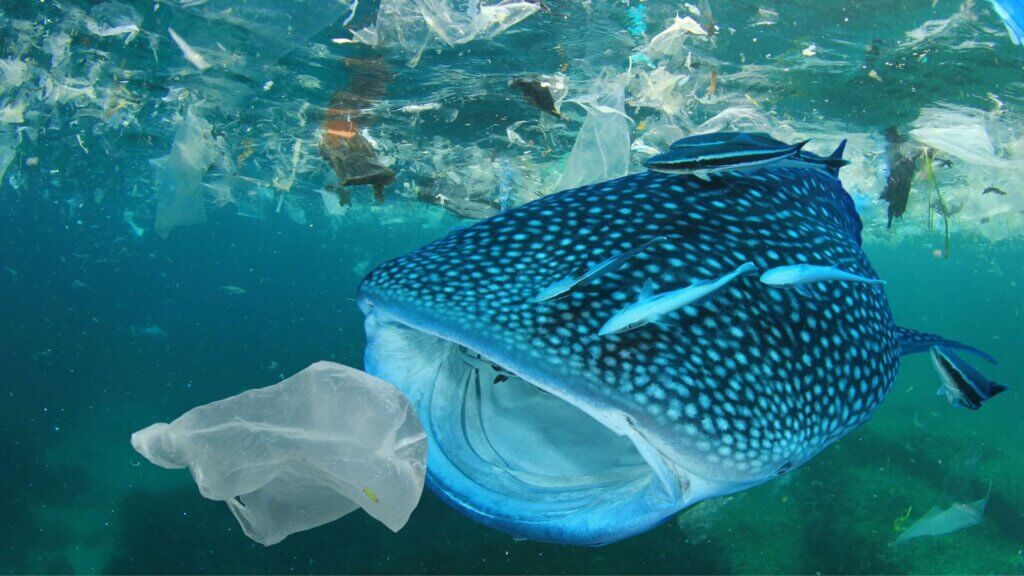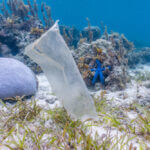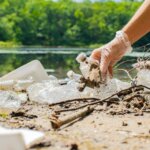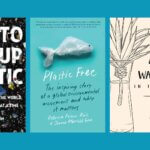Plastics in the Ocean (Fact Sheet)

Plastic pollution is present everywhere, from the deepest part of the ocean to the highest mountains on earth. In this article, we’ll share some facts about the environmental impact of plastic in our oceans.
The Environmental Impact of Plastic Waste in our Oceans
- It is estimated that up to 13 million metric tons of plastic (1) end up in the ocean every year, equivalent to a truckload of rubbish discharged every minute. This waste causes fish, seabirds, other sea creatures, and marine animals to entangle or ingest plastic debris, causing suffocation, starvation, and death.
- The biggest disadvantage of plastic is that it doesn’t decompose and can stick or move around indefinitely, polluting marine environments and damaging ecosystems. Some plastics float once they enter the ocean, and much of it breaks into tiny pieces forming microplastics that are eaten by sea creatures and animals, getting affected by their toxic effects. Microplastics in different forms are present in almost all water systems in the world, especially the oceans.
- According to the United Nations, at least 800 species worldwide are affected by ocean plastic pollution, and as much as 80% of the debris is from plastic. Over a million sea animals annually are killed by ingesting plastics. Many marine creatures are found dead with their stomachs full of plastic waste.
- Sea turtles worldwide are worst affected by plastic pollution as they have ingested plastic. Some starve to death as their stomachs become full. On many beaches, plastic pollution severely affects turtles’ reproduction rates by altering the temperatures of the sand where incubation occurs.
- Animals often starve by eating plastic because it prevents them from swallowing proper food. Scientists estimate that 60% of all seabird species consume plastic pieces (2), which may rise to 99% by 2050, considering the current trend.

Related: Why Shining a Light on the Planet vs Plastic Pollution Problem Can Inspire Change
Plastic is Linked to Disease in Corals
- Plastic waste can cause the growth of microbes and pathogens in the ocean. A 2018 study (3) reveals that corals get contaminated by plastic and have an 89% chance of communicating diseases, compared with a 4% likelihood for corals that do not come in contact with plastic waste. The chances of disease on a coral reef have been enhanced by 20 times due to the presence of plastics.
- The same 2018 study surveyed more than 120,000 corals, both plastic-free and with plastic present, on 159 reefs from Indonesia, Australia, Myanmar and Thailand, therefore across the Asia-Pacific region, estimating that over 11.1 billion plastic particles came in contact with corals. It was predicted that this number would increase by 40% by 2025. Plastic waste also causes physical damage to the corals and drastically exhausts natural resources.
- Why is the coral reef so crucial? The coral reef ecosystem is home to over 7,000 species of fish, invertebrates, plants, sea turtles, birds, and marine mammals. It represents over 25% of all marine inhabitants (4).
Related: These 100 Companies Produce 90% of the World’s Single Use Plastic
The 5 Gyres and The Great Pacific Garbage Patch
- Five massive patches of plastic debris are found in the oceans around the world, where there are huge concentrations of plastic waste covering large areas of the ocean. The largest amongst them, known as the “Great Pacific Garbage Patch (5)”, covers 20 million square kilometres of water, which has been estimated to be twice the size of Texas and three times the size of France. Marine species living in the Great Pacific Garbage Patch are severely affected by plastic waste and disrupting the natural marine ecosystem.
- Why these five massive patches? You might ask. The answer is that they follow the so called “5 gyres” which are large systems that help circulating ocean currents around the globe, similar to slow-moving whirlpools. These 5 gyres that have a significant impact on the global oceans are: the North Atlantic Gyre, the South Atlantic Gyre, the North Pacific Gyre, the South Pacific Gyre, and the Indian Ocean Gyre. While circulating ocean waters, these currents are also drawing in the pollution that we release in coastal areas, known as marine debris.
Related: 4 Ways Plastic Bottles Exacerbate Fuel & Energy Inefficiencies
Plastic Found in the Deepest Part of the Ocean: the Mariana Trench
- In a 2018 study (6), microplastic has been found at 36,000 feet (approximately 11km) in the Mariana Trench, the deepest part of the ocean, located in the western Pacific Ocean, about 200 kilometres (124 mi) east of the Mariana Islands. This indicates that even the deepest part of the world’s oceans cannot escape contamination from plastics. (On the other hand, it has also been found in the highest mountain peak, Mount Everest).
Related: How Can AI Help Clean up Plastics From Our Oceans and Waterways?
More Plastic Than Fish By 2050 (By Weight)
- Scientists predict that if action is not taken soon to address this serious problem, the weight of ocean plastics will exceed the combined weight of all of the fish in the seas by 2050 (7). When talking about plastics in the ocean, and we also add overfishing and the exploitation of fisheries, then we can understand how the world’s oceans are threatened and in danger.
Related: 45 Catchy No Plastic Slogans
References and Scientific Literature Sources:
(1) https://www.unep.org/resources/report/drowning-plastics-marine-litter-and-plastic-waste-vital-graphics
(2) https://www.csiro.au/en/news/All/News/2015/September/Marine-debris
(3) https://www.science.org/doi/10.1126/science.aar3320
(4) https://link.springer.com/chapter/10.1007/978-981-16-5403-9_13
(5) https://oceanservice.noaa.gov/podcast/mar18/nop14-ocean-garbage-patches.html
(6) https://www.geochemicalperspectivesletters.org/article1829/
(7) https://www.ellenmacarthurfoundation.org/plastics-and-the-circular-economy-deep-dive




